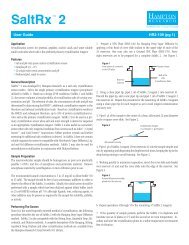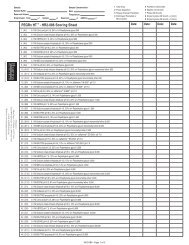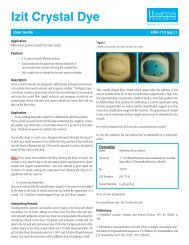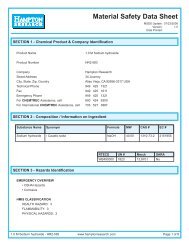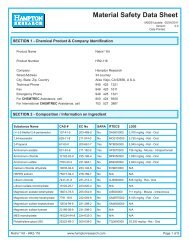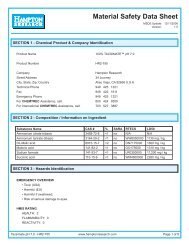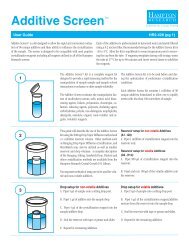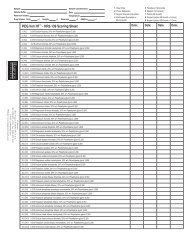Grid Screen PEG 6000 Documents - Hampton Research
Grid Screen PEG 6000 Documents - Hampton Research
Grid Screen PEG 6000 Documents - Hampton Research
- No tags were found...
You also want an ePaper? Increase the reach of your titles
YUMPU automatically turns print PDFs into web optimized ePapers that Google loves.
<strong>Grid</strong> <strong>Screen</strong>TM<strong>PEG</strong> <strong>6000</strong>Solutions for Crystal GrowthUser Guide HR2-213 (pg 1)<strong>Grid</strong> <strong>Screen</strong> TM <strong>PEG</strong> <strong>6000</strong> is a preformulated reagent kit designed to providea rapid screening method for the crystallization of biological macromolecules.The screen is simple and practical for finding initial crystallizationconditions as well as determining the solubility of a macromolecule in Polyethyleneglycol 6,000 between pH 4.0 and 9.0.Sample PreparationThe macromolecular sample should be homogenous, as pure as is practicallypossible (>95%) and free of amorphous and particulate material.Remove amorphous material by centrifugation or micro-filtration prior to(1, 2, 3)use.The recommended sample concentration is 5 to 25 mg/ml in water. Initially,the sample should be free of any unnecessary additives in order to observethe effect of the <strong>Grid</strong> <strong>Screen</strong> <strong>PEG</strong> <strong>6000</strong> variables. Ideally, the initial screenshould be performed with a sample which has been dialyzed against wateralthough ligands, ions, reducing agents, or other additives may be present asrequired by the sample for solubility, stability, or activity.Performing the <strong>Screen</strong>Since it is the most frequently reported method of crystallization, the followingprocedure describes the use of <strong>Grid</strong> <strong>Screen</strong> <strong>PEG</strong> <strong>6000</strong> with the HangingDrop Vapor Diffusion method. <strong>Grid</strong> <strong>Screen</strong> <strong>PEG</strong> <strong>6000</strong> is also very compatiblewith the Sitting Drop, Sandwich Drop, Microbatch, and Microdialysis methods.A complete description of the Hanging, Sitting, Sandwich Drop, Dialysisand other crystallization methods are available from the <strong>Hampton</strong> <strong>Research</strong>Crystal Growth 101 Library.1. Prepare a VDX Plate (HR3-140 and HR3-142) for Hanging Drop VaporDiffusion by applying a thin bead of cover slide sealant to the upper edge ofeach of the 24 reservoirs. One may also use a VDX TM Plate with sealant (HR3-170 and HR3-172). Twenty-four reservoirs are to be prepared for a complete<strong>Grid</strong> <strong>Screen</strong> <strong>PEG</strong> <strong>6000</strong>. See Figure 1.Figure 1Cross section of a reservoirin the VDX plate.ReservoirSolutionVacuum GreaseWell of theVDXCrystallization Plate2. Using a clean pipet tip, pipet 1 ml of <strong>Grid</strong> <strong>Screen</strong> <strong>PEG</strong> <strong>6000</strong> reagent A1 intoreservoir A1. Discard the pipet tip, add a new pipet tip and pipet 1 ml of <strong>Grid</strong><strong>Screen</strong> <strong>PEG</strong> <strong>6000</strong> reagent A2 into reservoir A2. Repeat the procedure for theremaining 22 <strong>Grid</strong> <strong>Screen</strong> <strong>PEG</strong> <strong>6000</strong> reagents using a clean pipet tip for eachreagent so as to avoid reagent contamination and carry over.3. Pipet 2 μl of the sample to the center of a clean, siliconized 22 mm diametercircle or square cover slide. See Figure 2.Figure 2Siliconized Coverslip4. Pipet 2 μl of <strong>Grid</strong> <strong>Screen</strong> <strong>PEG</strong> <strong>6000</strong> reagent A1 from reservoir A1 into thesample droplet and mix by aspirating and dispensing the droplet severaltimes, keeping the tip in the drop during mixing to avoid foaming. See Figure2.5. Working quickly to minimize evaporation, invert the cover slide and dropletover reservoir A1 and seal the cover slide onto the edge of the reservoir.See Figure 3.Figure 3Inverted Siliconized Coverslipplaced over the reservoir.Crystallization Droplet(2 ml Sample / 2 ml Reagent)6. Repeat operations 3 through 5 for the remaining 23 <strong>Grid</strong> <strong>Screen</strong> <strong>PEG</strong><strong>6000</strong> reagents.7. If the quantity of sample permits, perform <strong>Grid</strong> <strong>Screen</strong> <strong>PEG</strong> <strong>6000</strong> in duplicateand incubate one set of plates at 4°C and the second set at roomtemperature. Incubate and store the crystallization plates in a stable temperatureenvironment free of vibration.Examine the DropCarefully examine the drops under a stereo microscope (10 to 100x magnification)immediately after setting up the screen. Record all observations andbe particularly careful to scan the focal plane for small crystals. Observe thedrops once each day for the first week, then once a week there after. Recordsshould indicate whether the drop is clear, contains precipitate, and or crystals.It is helpful to describe the drop contents using descriptive terms. Addingmagnitude is also helpful. Example: 4+ yellow/brown fine precipitate, 2+small bipyramid crystals, clear drop, 3+ needle shaped crystals in 1+ whiteprecipitate. One may also employ a standard numerical scoring scheme(Clear = 0, Precipitate = 1, Crystal = 10, etc). Figure 4 (on page 2) showstypical examples of what one might observe in a crystallization experiment.Interpreting <strong>Grid</strong> <strong>Screen</strong> <strong>PEG</strong> <strong>6000</strong>Clear drops indicate that either the relative supersaturation of the sampleand reagent is too low or the drop has not yet completed equilibration. If thedrop remains clear after 3 to 4 weeks consider repeating the <strong>Grid</strong> <strong>Screen</strong> <strong>PEG</strong><strong>6000</strong> condition and doubling the sample concentration. If more than 70%
<strong>Grid</strong> <strong>Screen</strong>TM<strong>PEG</strong> <strong>6000</strong>Solutions for Crystal GrowthUser Guide HR2-213 (pg 2)Figure 4Typical observations in acrystallization experimentClear DropSkin/PrecipitatePrecipitatePrecipitate/PhaseQuasi CrystalsMicrocrystalsNeedle ClusterPlates<strong>Grid</strong> <strong>Screen</strong> <strong>PEG</strong> <strong>6000</strong> drops are clear consider doublingthe sample concentration and repeating the entire screen.Drops containing precipitate indicate that either the relativesupersaturation of the sample and reagent is too high,the sample has denatured, or the sample is heterogeneous.To reduce the relative supersaturation, dilute the sampletwofold and repeat the <strong>Grid</strong> <strong>Screen</strong> <strong>PEG</strong> <strong>6000</strong> condition.If more than 70% <strong>Grid</strong> <strong>Screen</strong> <strong>PEG</strong> <strong>6000</strong> drops containprecipitate and no crystals are present, consider dilutingthe sample concentration in half and repeating the entirescreen. If sample denaturation is suspect, take measures tostabilize the sample (add reducing agent, ligands, glycerol,salt, or other stabilizing agents). If the sample is impure,aggregated, or heterogeneous take measures to pursue homogeneity.It is possible to obtain crystals from precipitateso do not discard nor ignore a drop containing precipitate.If possible, examine drops containing precipitate under polarizingoptics to differentiate precipitate from microcrystallinematerial.If the drop contains a macromolecular crystal the relativesupersaturation of the sample and reagent is good. Thenext step is to optimize the preliminary conditions (pH,salt type, salt concentration, precipitant type, precipitantconcentration, sample concentration, temperature, additives,and other crystallization variables) which producedthe crystal in order to improve crystal size and quality.Compare the observations between the 4°C and room temperatureincubation to determine the effect of temperatureon sample solubility. Different results in the same drops atdifferent temperatures indicate that sample solubility istemperature dependent and that one should include temperatureas a variable in subsequent screens and optimizationexperiments.<strong>Grid</strong> <strong>Screen</strong> <strong>PEG</strong> <strong>6000</strong> reagents are stable at room temperatureand are best if used within 12 months of receipt. Toenhance reagent stability it is strongly recommended that<strong>Grid</strong> <strong>Screen</strong> <strong>PEG</strong> <strong>6000</strong> be stored at 4°C or -20°C. Avoid ultravioletlight to preserve reagent stability.References and Readings1. Crystallization of nucleic acids and proteins, Edited by A.Ducruix and R. Giege, The Practical Approach Series, OxfordUniv. Press, 1992.2. Current approaches to macromolecular crystallization.McPherson, A. Eur. J. Biochem. 189, 1-23, 1990.3. Protein and Nucleic Acid Crystallization. Methods, ACompanion to Methods in Enzymology, Academic Press,Volume 1, Number 1, August 1990.4. Advance in Protein Chemistry Volume 41. Pages 1-33(Patricia C. Weber). Academic Press, 1991.5. Current approaches to macromolecular crystallization.,McPherson, A., Eur. J. Biochem. 189, 1-23, 1990.6. Crystallization of Membrane Proteins. Edited by HartmutMichel,1990. CRC Press.Technical SupportInquiries regarding <strong>Grid</strong> <strong>Screen</strong> <strong>PEG</strong> <strong>6000</strong> reagent formulation,interpretation of screen results, optimization strategiesand general inquiries regarding crystallization arewelcome. Please e-mail, fax, or telephone your request to<strong>Hampton</strong> <strong>Research</strong>. Fax and e-mail Technical Support areavailable 24 hours a day. Telephone technical support isavailable 8:00 a.m. to 5:00 p.m. USA Pacific Standard Time.Rod ClusterSingle CrystalRetain and observe plates until the drops are dried out.Crystal growth can occur within 15 minutes or one year.<strong>Grid</strong> <strong>Screen</strong> <strong>PEG</strong> <strong>6000</strong> Formulation<strong>Grid</strong> <strong>Screen</strong> <strong>PEG</strong> <strong>6000</strong> reagents are formulated using thehighest purity chemicals, ultrapure water (18.2 Megohmcm,5 ppb TOC) and are sterile filtered using 0.22 micronfilters into sterile containers (no preservatives added).
<strong>Grid</strong> <strong>Screen</strong> <strong>PEG</strong> <strong>6000</strong>HR2-213 Reagent Formulation and Specification Data Sheet[ Polyethylene glycol 6,000 (% w/v) ]51020304 5 6 7 8 9A1 A2 A3 A4 A5 A6B1C1D1B2C2D2B3C3D3pHB4C4D4B5C5D5B6C6D6The pH indicated on each <strong>Grid</strong> <strong>Screen</strong> reagent isthe ACTUAL pH of the reagent at 25.0 ° C. All pHadjustments have been made using Hydrochloricacid or Sodium hydroxide.Tube Polyethylene glycol 6,000# [ % w/v ]A1. 5B1. 10C1. 20D1. 30A2. 5B2. 10C2. 20D2. 30A3. 5B3. 10C3. 20D3. 30A4. 5B4. 10C4. 20D4. 30A5. 5B5. 10C5. 20D5. 30A6. 5B6. 10C6. 20D6. 30Tube#BufferA1. 0.1 M Citric acid pH 4.0B1. 0.1 M Citric acid pH 4.0C1. 0.1 M Citric acid pH 4.0D1. 0.1 M Citric acid pH 4.0A2. 0.1 M Citric acid pH 5.0B2. 0.1 M Citric acid pH 5.0C2. 0.1 M Citric acid pH 5.0D2. 0.1 M Citric acid pH 5.0A3. 0.1 M MES monohydrate pH 6.0B3. 0.1 M MES monohydrate pH 6.0C3. 0.1 M MES monohydrate pH 6.0D3. 0.1 M MES monohydrate pH 6.0A4. 0.1 M HEPES pH 7.0B4. 0.1 M HEPES pH 7.0C4. 0.1 M HEPES pH 7.0D4. 0.1 M HEPES pH 7.0A5. 0.1 M Tris pH 8.0B5. 0.1 M Tris pH 8.0C5. 0.1 M Tris pH 8.0D5. 0.1 M Tris pH 8.0A6. 0.1 M BICINE pH 9.0B6. 0.1 M BICINE pH 9.0C6. 0.1 M BICINE pH 9.0D6. 0.1 M BICINE pH 9.0Chemical Analysis and Recommended Optimization ReagentsHR2-533 - 50% w/v Polyethylene glycol 6,000, 200 milliliters Mr 5,000-7,000 H(OCH2CH2)nOH CAS Number [ 25322-68-3 ] EC No 500-038-2HR2-831 - 1.0 M Citric acid, 100 milliliters Mr 192.13 C6H8O7 CAS Number [ 77-92-9 ] EC No 201-069-1HR2-587 - 0.5 M MES monohydrate, 100 milliliters Mr 213.25 C6H13NO4S · H2O CAS Number [ 145224-94-8 ] EC No 224-632-3HR2-585 - 1.0 M HEPES, 100 milliliters Mr 238.31 C8H18N2O4S CAS Number [ 7365-45-9 ] EC No 230-907-9HR2-589 - 1.0 M Tris, 100 milliliters Mr 121.14 C4H11NO3 CAS Number [ 77-86-1 ] EC No 201-064-4HR2-509 - 1.0 M BICINE, 100 milliliters Mr 163.17 C6H13NO4 CAS Number [ 150-25-4 ] EC No 205-755-1Solutions for Crystal Growth
Sample:Sample Buffer:Reservoir Volume:Sample Concentration:Date:Temperature:Drop Volume: Total ml Sample ml Reservoir ml Additive ml1 Clear Drop2 Phase Separation3 Regular Granular Precipitate4 Birefringent Precipitate orMicrocrystals5 Posettes or Spherulites6 Needles (1D Growth)7 Plates (2D Growth)8 Single Crystals (3D Growth < 0.2 mm)9 Single Crystals (3D Growth > 0.2 mm)<strong>Grid</strong> <strong>Screen</strong> <strong>PEG</strong> <strong>6000</strong> - HR2-213 Scoring SheetDate: Date: Date: Date:A1. 0.1 M Citric acid pH 4.0, 5% w/v Polyethylene glycol 6,000A2. 0.1 M Citric acid pH 5.0, 5% w/v Polyethylene glycol 6,000A3. 0.1 M MES monohydrate pH 6.0, 5% w/v Polyethylene glycol 6,000A4. 0.1 M HEPES pH 7.0, 5% w/v Polyethylene glycol 6,000A5. 0.1 M Tris pH 8.0, 5% w/v Polyethylene glycol 6,000A6. 0.1 M BICINE pH 9.0, 5% w/v Polyethylene glycol 6,000B1. 0.1 M Citric acid pH 4.0, 10% w/v Polyethylene glycol 6,000B2. 0.1 M Citric acid pH 5.0, 10% w/v Polyethylene glycol 6,000B3. 0.1 M MES monohydrate pH 6.0, 10% w/v Polyethylene glycol 6,000B4. 0.1 M HEPES pH 7.0, 10% w/v Polyethylene glycol 6,000B5. 0.1 M Tris pH 8.0, 10% w/v Polyethylene glycol 6,000B6. 0.1 M BICINE pH 9.0, 10% w/v Polyethylene glycol 6,000C1. 0.1 M Citric acid pH 4.0, 20% w/v Polyethylene glycol 6,000C2. 0.1 M Citric acid pH 5.0, 20% w/v Polyethylene glycol 6,000C3. 0.1 M MES monohydrate pH 6.0, 20% w/v Polyethylene glycol 6,000C4. 0.1 M HEPES pH 7.0, 20% w/v Polyethylene glycol 6,000C5. 0.1 M Tris pH 8.0, 20% w/v Polyethylene glycol 6,000C6. 0.1 M BICINE pH 9.0, 20% w/v Polyethylene glycol 6,000D1. 0.1 M Citric acid pH 4.0, 30% w/v Polyethylene glycol 6,000D2. 0.1 M Citric acid pH 5.0, 30% w/v Polyethylene glycol 6,000D3. 0.1 M MES monohydrate pH 6.0, 30% w/v Polyethylene glycol 6,000D4. 0.1 M HEPES pH 7.0, 30% w/v Polyethylene glycol 6,000D5. 0.1 M Tris pH 8.0, 30% w/v Polyethylene glycol 6,000D6. 0.1 M BICINE pH 9.0, 30% w/v Polyethylene glycol 6,000Solutions for Crystal Growth



